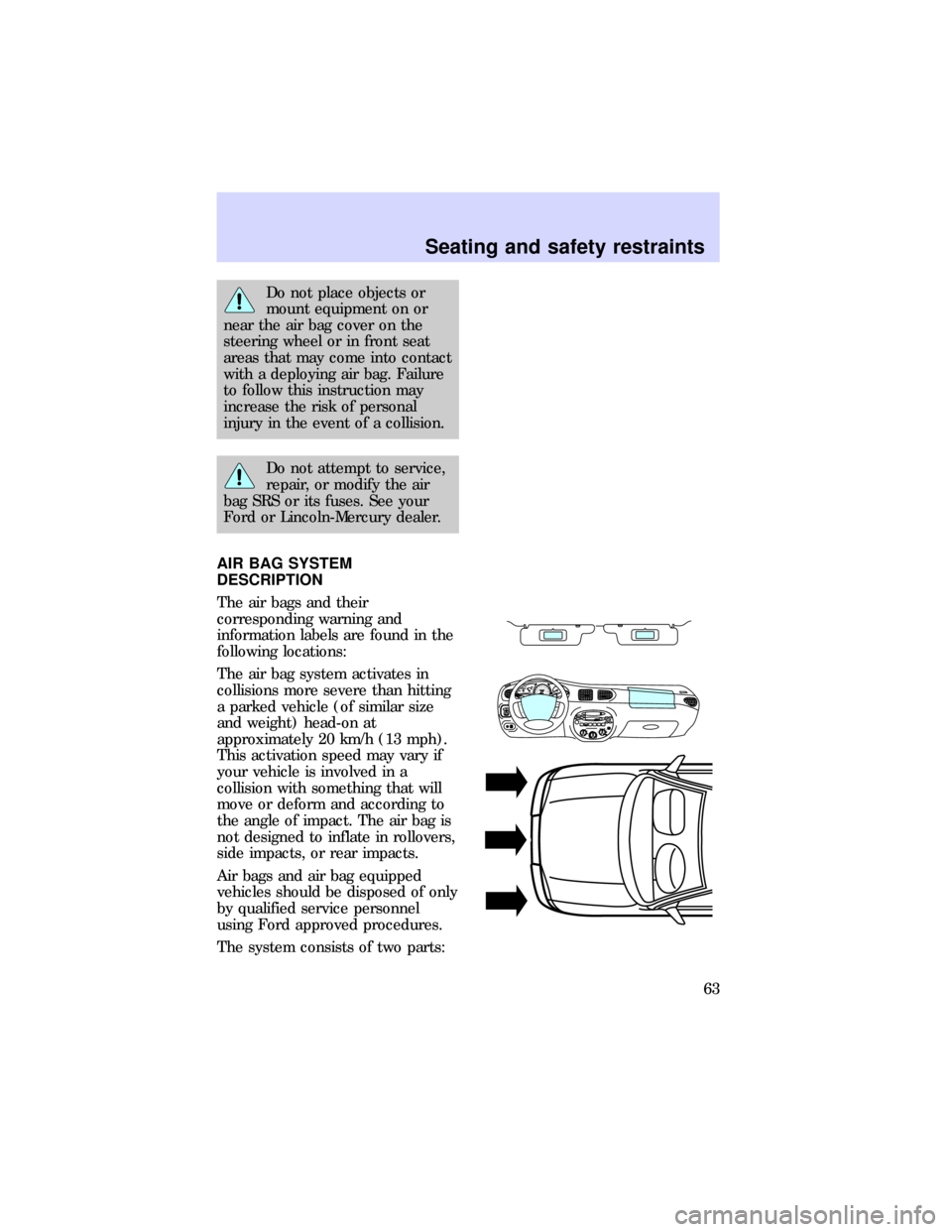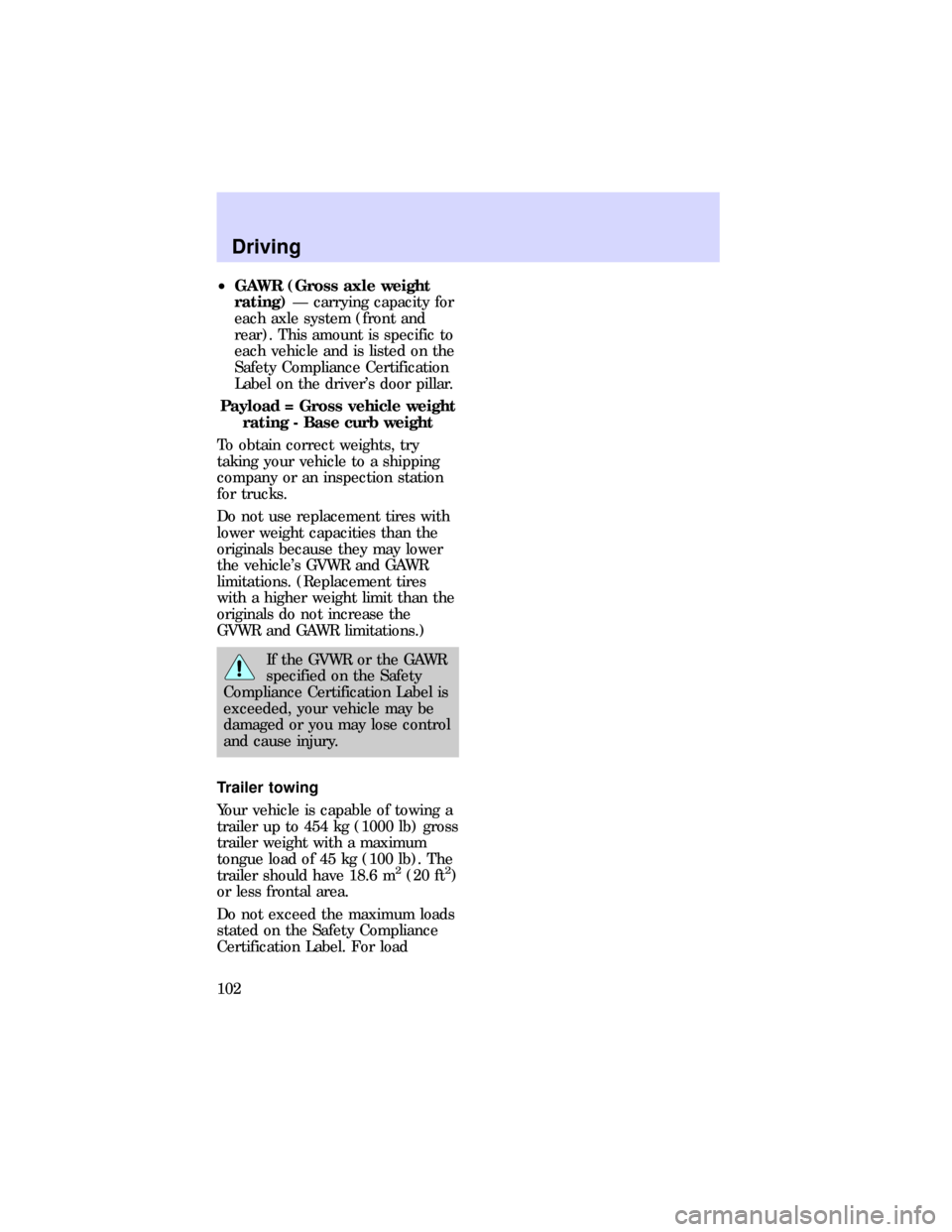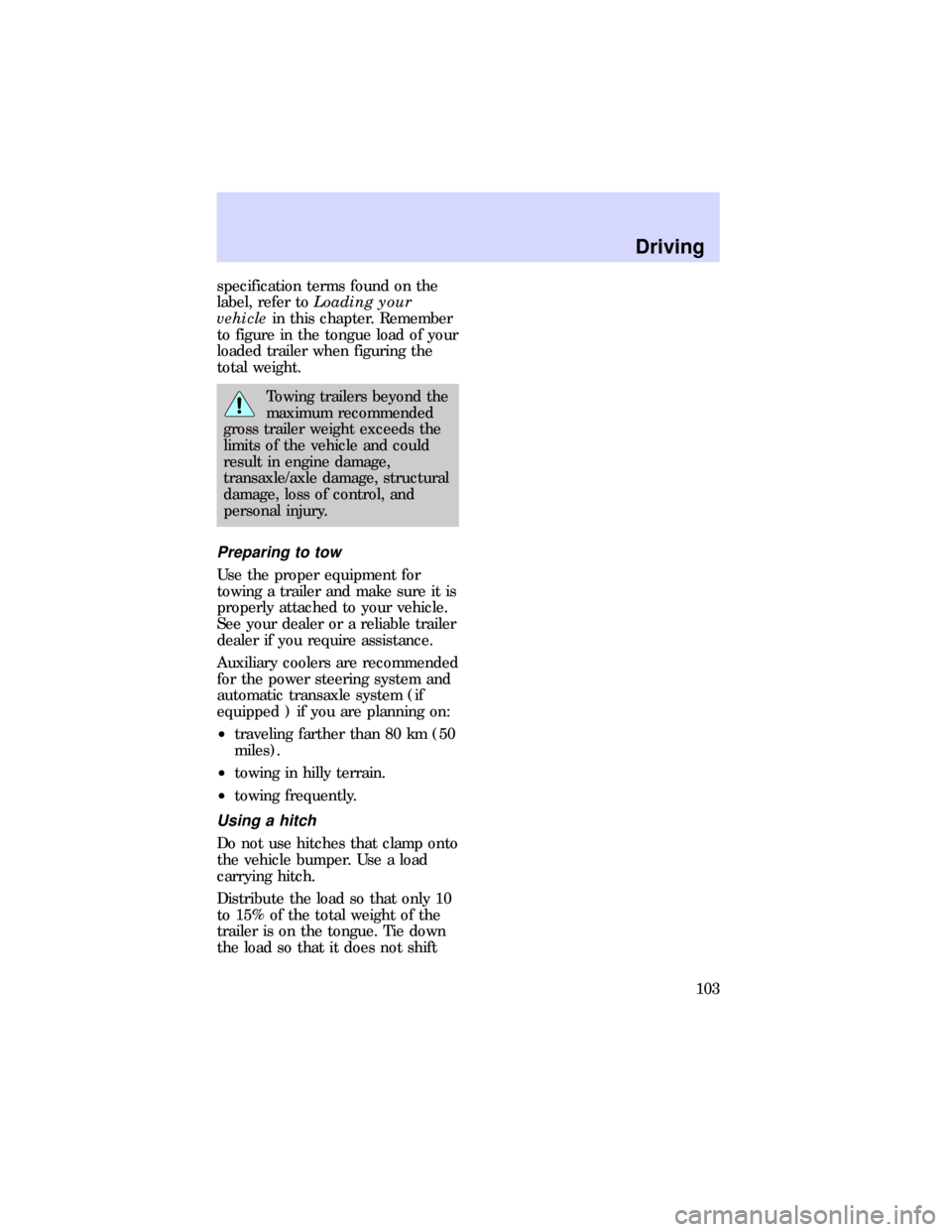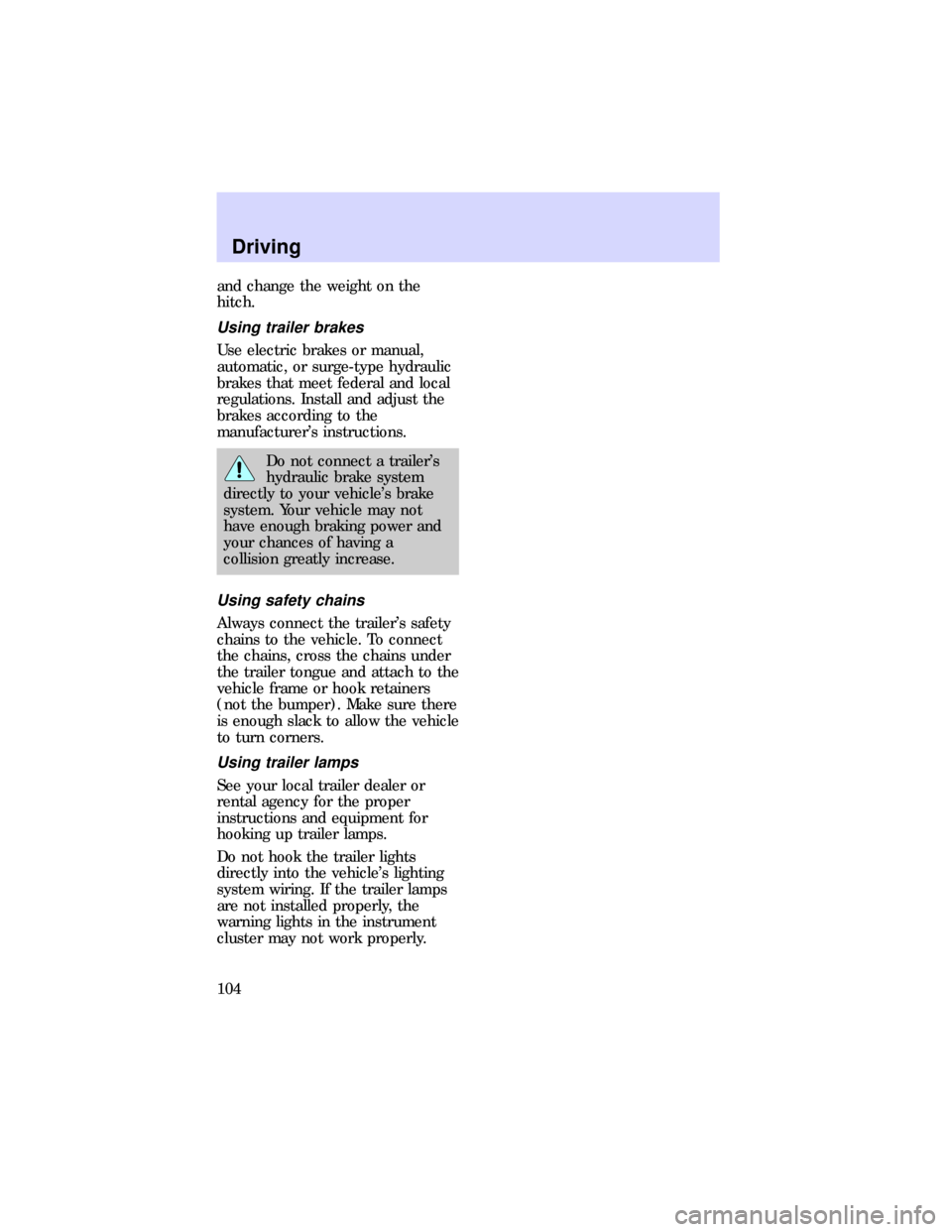1997 FORD ESCORT weight
[x] Cancel search: weightPage 63 of 191

Do not place objects or
mount equipment on or
near the air bag cover on the
steering wheel or in front seat
areas that may come into contact
with a deploying air bag. Failure
to follow this instruction may
increase the risk of personal
injury in the event of a collision.
Do not attempt to service,
repair, or modify the air
bag SRS or its fuses. See your
Ford or Lincoln-Mercury dealer.
AIR BAG SYSTEM
DESCRIPTION
The air bags and their
corresponding warning and
information labels are found in the
following locations:
The air bag system activates in
collisions more severe than hitting
a parked vehicle (of similar size
and weight) head-on at
approximately 20 km/h (13 mph).
This activation speed may vary if
your vehicle is involved in a
collision with something that will
move or deform and according to
the angle of impact. The air bag is
not designed to inflate in rollovers,
side impacts, or rear impacts.
Air bags and air bag equipped
vehicles should be disposed of only
by qualified service personnel
using Ford approved procedures.
The system consists of two parts:
HI LOOFF*A/C*MAX
A/CTUNE
DISCS
SEEK
TUNE
SCAN
EJ REW FF
BAL BASSTREBFADE TAPE
CD AM
FM
–+1
SIDE 1-22
345
COMP1
SIDE 1-2VOL–
PUSH ONLMIRRORR00000000002030405060
70
80
90
10 0
11 020 40608010 0
12 0
16 0
18 0 140
200FUEL FILLCHEF1/22
13RPM x 1000RSM
SET
ACC
CST OFF ONOFFINT
1 OFF MIST
Seating and safety restraints
63
Page 101 of 191

²Do not drive with your foot
resting on the clutch pedal and do
not use the clutch pedal to hold
the vehicle at a standstill. These
actions will reduce clutch life.
²Downshift on steep hills to
reduce the vehicle's chances of
stalling and to prevent
unnecessary brake wear.
LOADING YOUR VEHICLE
Before loading a vehicle, familiarize
yourself with these terms:
²Base curb weightÐ weight of
the vehicle including any
standard equipment, fluids,
lubricants, etc. It does not
include passengers or
aftermarket equipment.
²PayloadÐ combined maximum
allowable weight of cargo,
passengers and optional
equipment.
²GVW (Gross vehicle weight)
Ðbase curb weight plus the
payload weight (including
passengers, cargo and optional
equipment). Remember, the
GVW is not a limit or a
specification.
²GVWR (Gross vehicle weight
rating)Ð maximum total
weight of the base vehicle,
passengers, optional equipment,
and cargo. The GVWR is specific
to each vehicle and is listed on
the Safety Compliance
Certification Label on the
driver's door pillar.
Driving
101
Page 102 of 191

²GAWR (Gross axle weight
rating)Ð carrying capacity for
each axle system (front and
rear). This amount is specific to
each vehicle and is listed on the
Safety Compliance Certification
Label on the driver's door pillar.
Payload = Gross vehicle weight
rating - Base curb weight
To obtain correct weights, try
taking your vehicle to a shipping
company or an inspection station
for trucks.
Do not use replacement tires with
lower weight capacities than the
originals because they may lower
the vehicle's GVWR and GAWR
limitations. (Replacement tires
with a higher weight limit than the
originals do not increase the
GVWR and GAWR limitations.)
If the GVWR or the GAWR
specified on the Safety
Compliance Certification Label is
exceeded, your vehicle may be
damaged or you may lose control
and cause injury.
Trailer towing
Your vehicle is capable of towing a
trailer up to 454 kg (1000 lb) gross
trailer weight with a maximum
tongue load of 45 kg (100 lb). The
trailer should have 18.6 m
2(20 ft2)
or less frontal area.
Do not exceed the maximum loads
stated on the Safety Compliance
Certification Label. For load
Driving
102
Page 103 of 191

specification terms found on the
label, refer toLoading your
vehiclein this chapter. Remember
to figure in the tongue load of your
loaded trailer when figuring the
total weight.
Towing trailers beyond the
maximum recommended
gross trailer weight exceeds the
limits of the vehicle and could
result in engine damage,
transaxle/axle damage, structural
damage, loss of control, and
personal injury.
Preparing to tow
Use the proper equipment for
towing a trailer and make sure it is
properly attached to your vehicle.
See your dealer or a reliable trailer
dealer if you require assistance.
Auxiliary coolers are recommended
for the power steering system and
automatic transaxle system (if
equipped ) if you are planning on:
²traveling farther than 80 km (50
miles).
²towing in hilly terrain.
²towing frequently.
Using a hitch
Do not use hitches that clamp onto
the vehicle bumper. Use a load
carrying hitch.
Distribute the load so that only 10
to 15% of the total weight of the
trailer is on the tongue. Tie down
the load so that it does not shift
Driving
103
Page 104 of 191

and change the weight on the
hitch.
Using trailer brakes
Use electric brakes or manual,
automatic, or surge-type hydraulic
brakes that meet federal and local
regulations. Install and adjust the
brakes according to the
manufacturer's instructions.
Do not connect a trailer's
hydraulic brake system
directly to your vehicle's brake
system. Your vehicle may not
have enough braking power and
your chances of having a
collision greatly increase.
Using safety chains
Always connect the trailer's safety
chains to the vehicle. To connect
the chains, cross the chains under
the trailer tongue and attach to the
vehicle frame or hook retainers
(not the bumper). Make sure there
is enough slack to allow the vehicle
to turn corners.
Using trailer lamps
See your local trailer dealer or
rental agency for the proper
instructions and equipment for
hooking up trailer lamps.
Do not hook the trailer lights
directly into the vehicle's lighting
system wiring. If the trailer lamps
are not installed properly, the
warning lights in the instrument
cluster may not work properly.
Driving
104
Page 105 of 191

Driving while towing a trailer
Do not drive faster than 88 km/h
(55 mph) while towing a 454 kg
(1000 lb) trailer. Do not drive
faster than 72 km/h (45 mph) with
any weight trailer while towing in
hilly country or on hot days.
Speed control (if equipped) may
not work properly while towing on
very long, steep grades.
If driving with an automatic
transaxle:
²use D or L rather than
Dwhile towing up or down
steep hills.
²anticipate stops and brake
gradually.
If driving with a manual transaxle:
²select a gear that avoids jerking
or excessive engine speed.
²avoid driving excessively in first
or second gear. In first or
second gear the trailer may be
too big or too heavily loaded for
the vehicle drivetrain.
²shift to a lower gear while
towing up or down steep hills.
²anticipate stops and brake
gradually.
Servicing while towing
If you tow a trailer for long
distances, your vehicle requires
more frequent service than a
vehicle not used for towing. Refer
to theService Guidefor more
information.
Driving
105
Page 106 of 191

Towing behind a recreational
vehicle (RV)
Do not tow your vehicle behind
another vehicle, such as an RV,
unless front wheel dollies are used.
Luggage rack (if equipped)
Load luggage as far back as it will
safely go on the rack without
causing the vehicle to exceed the
gross vehicle weight rating
(GVWR) or gross axle weight
rating (GAWR).
FUEL CONSUMPTION
Fuel economy can be improved by
avoiding:
²lack of regular, scheduled
maintenance
²excessive speed
²rapid acceleration
²driving with the brake pedal
depressed
²sudden stops
²extended engine idling
²use of speed control in hilly
terrain
²extended use of the air
conditioner, defroster, rear
window defroster and other
accessories
²underinflated tires
²heavy loads
²aftermarket add-ons such as
bike, ski or luggage racks, bug
deflectors, etc.
Driving
106
Page 188 of 191

Engine oil ..................................130
check oil warning light ...............9
checking and adding ..............130
Exhaust fumes ............................91
Fan ...............................................18
Flashing the lights ......................27
Floor mats ...................................39
Foglamps ..............................27,163
Fuel
capacity ...................................179
improving fuel economy ........106
low fuel warning light ................7
safety information relating to
automotive fuels .....................153
Fuel pump shut-off switch ..43,107
starting after a collision ...........43
Fuse panels
engine compartment ..............113
instrument panel ....................111
Fuses ..........................................109
charts ................................111,113
checking and replacing ..........109
circuit breakers .......................110
Gauges, Electronic ......................12
Gauges, Mechanical ....................12
engine coolant temperature
gauge .........................................13
fuel gauge ..................................13
odometer ...................................14
speedometer .............................13
trip odometer ............................14
Gearshift .................................36,97
GVWR (Gross Vehicle Weight
Rating) .......................................101
definition .................................101
Hazard flashers ....................29,107
Head restraints ...........................54
Headlamps
daytime running lights .............26
replacing bulbs .......................162
turning on and off ....................26High beams
indicator light .............................9
operation ...................................27
High-mount brakelamp
replacing the bulb ..................164
Hood ..........................................128
prop rod ..................................128
release lever ............................128
working under the hood ........124
Idle
relearning ................................144
Ignition
positions of the ignition ...........25
Inspection/maintenance (I/M)
testing ........................................158
Instrument cluster
sport .........................................6,7
standard ......................................6
Instrument panel ........................15
lighting up panel and interior 6,15
location of components ...........4,5
Interval wipers ............................30
Jump-starting your vehicle ......120
attaching cables ......................121
disconnecting cables ..............122
Lamps ........................................160
bulb replacement
specifications chart ................172
daytime running light system ..26
dome lamps .............................170
fog lamps ............................27,163
headlamps ..........................26,162
high beams ................................27
high-mount brakelamp ...........164
illuminated entry system .........33
interior lamps ....................31,170
map lamps ..........................31,171
replacing bulbs .......................160
tail lamps ..........................167,168
License plate lamps ..................165
Liftgate .................................40,164
warning light .............................10
Index
188